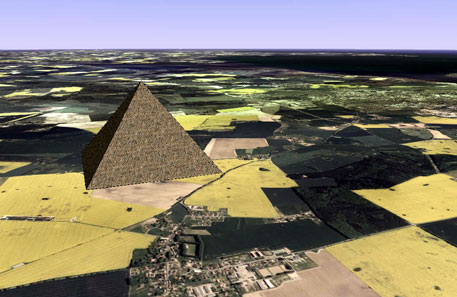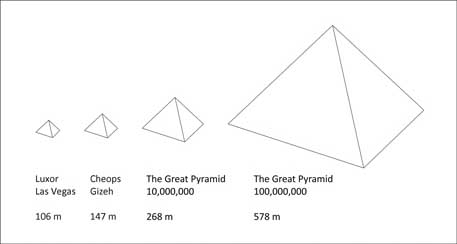Bauhaus Pyramid
The German town of Dessau, home of the Bauhaus, may someday construct its own Great Pyramid.
"The pharaohs may have set the standard," the Telegraph reports, "but German entrepreneurs are hoping to challenge Egypt's pre-eminence in monumental self-indulgence by building the world's largest pyramid."
 The Telegraph somewhat cynically continues, explaining that this "improbable plan is based on the belief that people will pay to have their ashes encased in the concrete blocks used to construct the monument."
The Telegraph somewhat cynically continues, explaining that this "improbable plan is based on the belief that people will pay to have their ashes encased in the concrete blocks used to construct the monument."
If that does turn out to be the case, however, then these German entrepreneurs "will be rich beyond the wildest dreams of even the most ambitious pharaoh."
In any case, the concrete structure itself – why not granite? let's please build huge structures out of stone again – would act as a "memorial site" for people "of all nationalities and religions."
You don't actually have to be buried there, meanwhile; you can "opt to have a memorial stone placed instead." Your stone can even be "designed with any number of colors" – instantly transforming the Great Pyramid into a badly weathered mountain of tinted concrete, cracked and stained more and more every winter as it stands in the heart of an east German floodplain.
 Still, the entrepreneurs are optimistic:
Still, the entrepreneurs are optimistic:
The original plans called for "an overall height of some 1,600ft," the Independent reports, "but the proposal has already been dramatically scaled down. The revised plans are for a pyramid of some 492ft."
1) What does Michiel think of this? 2) Will it cause earthquakes?
(Thanks, John!)
"The pharaohs may have set the standard," the Telegraph reports, "but German entrepreneurs are hoping to challenge Egypt's pre-eminence in monumental self-indulgence by building the world's largest pyramid."
 The Telegraph somewhat cynically continues, explaining that this "improbable plan is based on the belief that people will pay to have their ashes encased in the concrete blocks used to construct the monument."
The Telegraph somewhat cynically continues, explaining that this "improbable plan is based on the belief that people will pay to have their ashes encased in the concrete blocks used to construct the monument." If that does turn out to be the case, however, then these German entrepreneurs "will be rich beyond the wildest dreams of even the most ambitious pharaoh."
- The blocks are expected to be up to one cubic metre in size and, given that the volume of the completed pyramid is likely to be in excess of 40 million cubic metres, it could ultimately bring in £13.2 billion.
In any case, the concrete structure itself – why not granite? let's please build huge structures out of stone again – would act as a "memorial site" for people "of all nationalities and religions."
You don't actually have to be buried there, meanwhile; you can "opt to have a memorial stone placed instead." Your stone can even be "designed with any number of colors" – instantly transforming the Great Pyramid into a badly weathered mountain of tinted concrete, cracked and stained more and more every winter as it stands in the heart of an east German floodplain.
 Still, the entrepreneurs are optimistic:
Still, the entrepreneurs are optimistic:- The Great Pyramid will continue to grow with every stone placed, eventually forming the largest structure in the history of man.
The original plans called for "an overall height of some 1,600ft," the Independent reports, "but the proposal has already been dramatically scaled down. The revised plans are for a pyramid of some 492ft."
1) What does Michiel think of this? 2) Will it cause earthquakes?
(Thanks, John!)





Comments are moderated.
If it's not spam, it will appear here shortly!
Hi Geoff and everybody,
a few tiny things:
1) "Home of the Bauhaus" is rather Weimar than Dessau. Bauhaus moved there after the Nazis forced the school to leave Weimar. The city council is discussing our proposal though we didn´t even ask officially. So far Bojan at The Telegraph is right.
2) We know, it´s´hard to grasp, but there is no target size. The new Great Pyramid would grow with every stone set. It´s a tribute place. We expect and desire, most stones would be set not by people for themselves, but to honour former people we would like to say "Thanks for having been around and inspring us". It´s worth it we reckon - and a completely open structure.
3) A pyramid-shaped structure is nothing fancy. Death is nothing fancy. But still there´s some obvious need to comfort ourselves with that 100% certain perspective and come to terms how all of us will be remembered.
4) Ever thought, why all these online cemeteries failed?
5) Good to be on BLDBLOG, which we read for years already. Thanks and take care.
that's kind of bad taste isn't it? especially to be endorosed by rem koolhaas.
Hi Geoff,
Something similar that you may find interesting is The Mastaba: Project for the United Arab Emirates, a 150m (that's 492ft again)-tall structure of "approximately 390,500 horizontally stacked oil barrels" and "a work of art whose only purpose is to be itself". Christo and Jeanne-Claude, the artists who wrapped the Reichstag, have been planning it since 1978.
Cheers,
Earle
Now we know what Michiel thinks...
Thanks, Earle!
And, Jens, thanks for dropping by. I'm interested to see how a concrete pyramid might weather in a floodplain - keep me updated.
Have you read about the pyramid of Primrose Hill?
Plans for colossal pyramids always remind me of The Last Redoubt in William Hope Hodgson's fantasy/horror novel The Night Land. A vast (mile high?) metal pyramid containing the remains of humanity on a dead Earth besieged by monsters.
http://www.thenightland.co.uk/nightmap.html
Pyramids cost a lot to assemble: in 1973 a USA construction company figured The Great Pyramid of Egypt would cost 1.130490000 billion dollars--adding for inflation (up to 2006) that would now be about 526.274952 billions! Next, the "lifetime" of a pyramid of stoned persons in humid Germany would be far less than 100,000 years for Cheop's Pyramid in dry Egypt [K.O. Emery, "Weathering of the Great Pyramid", JOURNAL OF SEDIMENTARY PETROLOGY 30 (1): 140-143 (March 1960)]
Many ask, how the pyramid can withstand the environmental influences
and the climate in Germany.
First: It is a long term project. Who knows whether not soon prevails
climate as in North Africa? (Just kidding)
Second: We chose a manner, where the surface of the pyramid renews
itself again and again. After not to long time the new stones do
protect the underlying old. Thus it is guaranteed that the pyramid
looks always finished and brand new.
We call it the American-Indians manner (from the inside outward), in
opposition of the egyptian manner: (layer by layer).
Thus it is also possible, simply beginning without definition of the
final dimensions.
So just begin and let the pyramid grow.
We also know about a feasibility study from a german construction company (now broken) from 1999. There clone of the Cheop´s Pyramid in Cologne would cost (transformed in 2008) 4,5 Billion Euro. But 80% of the total cost comes from the natural material, cutting, polishing and transport the stones. The calculate with 2 Million stones in different size (up to 40 Tonnes). We calculate whit 5 Million concrete blocks (half cubic meters concrete), manufactured near the pyramid. Big scale effects make it efficiently, we think.
And the architectural challenge is the area around the Pyramid and how this can grow up whit the Pyramid.
So stay tuned and don´t let fool about the size - it´s the process!
4) Ever thought, why all these online cemeteries failed?
Aren't geneological websites some of the most popular on the interweb?
Post a Comment